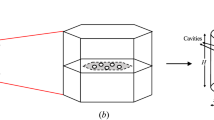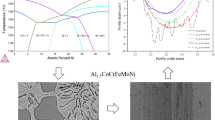Abstract
The effects of indentation loading depth and dynamic pre-compression on the creep behavior of CoCrFeNiAl0.3 high-entropy alloy (HEA) were studied through a series of indentation creep tests. Results show that the creep displacement, creep stress exponent and creep strain rate are all sensitive to loading depth. A phenomenological model based on the holding time and loading depth was established by studying the characteristic relation between the loading depth and the creep displacement of CoCrFeNiAl0.3 HEA. The phenomenological model was used to analyze the creep behavior of the alloy under dynamic pre-compression (i.e., dynamic compressive deformation caused by Hopkinson bar impact).






Similar content being viewed by others
Availability of Data and Materials
The datasets used and analyzed during the current study are available from the corresponding author on reasonable request.
References
Yeh JW, Chen YL, Lin SJ. High-entropy alloys—a new era of exploitation. Mater Sci Forum. 2007;560:1–9.
Fischer-Cripps AC. Nanoindentation. New York: Springer; 2011.
Meng L, Qiu J, Wang ZH, Liu RQ, Shu XF, Xiao GS. Indentation pop-in behavior of CoCrFeNiAl0.3 high-entropy alloy. Mater Res Express. 2020;6(12):1265d4.
Xiao GS, Yang XX, Qiu J, et al. Determination of power hardening elastoplastic constitutive relation of metals through indentation tests with plural indenters. Mech Mater. 2019;138:103173.
Lucas BN, Oliver WC. Indentation power-law creep of high-purity indium. Metall Mater Trans A. 1999;30:601–10.
Yang TQ. The ory of viscoelaticity. Wuhan: Huazhong University of Science and Technology Press; 1990.
Hu J, Sun G, Zhang X, Wang G, Jiang Z, Han S, et al. Effects of loading strain rate and stacking fault energy on nanoindentation creep behaviors of nanocrystalline Cu, Ni-20 wt.%Fe and Ni. J Alloys Compd. 2015;647(1):670–80.
Zhou PF, Xiao DH, Li G, Song M. Nanoindentation creep behavior of CoCrFeNiMn high-entropy alloy under different high-pressure torsion deformations. J Mater Eng Perform. 2019;28(5):2620–9.
Pharr GM, Oliver WC, Brotzen FR. On the generality of the relationship among contact stiffness, contact area, and elastic modulus during indentation. J Mater Res. 1992;7(03):613–7.
Yang S, Zhang YW, Zeng K. Analysis of nanoindentation creep for polymeric materials. J Appl Phys. 2004;95(7):3655.
Dirras G, Couque H, Lilensten L, Heczel A, Tingaud D, Couzinié JP, et al. Mechanical behavior and microstructure of Ti20Hf20Zr20Ta20Nb20 high-entropy alloy loaded under quasi-static and dynamic compression conditions. Mater Charact. 2016;111:106–13.
Wang L, Qiao JW, Ma SG, Jiao ZM, Zhang TW, Chen G. Mechanical response and deformation behavior of Al0.6CoCrFeNi high-entropy alloys upon dynamic loading. Mater Sci Eng. 2018;727:208–13.
Meyers MA. Dynamic behavior of materials. New York: Wiley; 1994.
Kassner ME. Fundamentals of creep in metals and alloys. London: Butterworth-Heinemann, an imprint of Elsevier; 2009.
Mayo MJ, Nix WDA. micro-indentation study of superplasticity in Pb, Sn, and Sn-38 wt% Pb. Acta Metall. 1988;36(8):2183–92.
Raman V, Berriche R. An investigation of the creep processes in tin and aluminum using a depth-sensing indentation technique. J Mater Res. 1992;7(3):627–38.
Oliver WC, Pharr GM. An improved technique for determining hardness and elastic modulus using load and displacement sensing indentation experiments. J Mater Res. 1992;7(6):1564–83.
Cao ZH, Li PY, Lu HM, Huang YL, et al. Indentation size effects on the creep behavior of nanocrystalline tetragonal Ta films. Scr Mater. 2009;60(6):415–8.
Wang F, Huang P, Xu KW. Time dependent plasticity at real nanoscale deformation. Appl Phys Lett. 2007;90(16):161921.
Zhang L, Yu P, Cheng H, Zhang H, Diao H, Shi Y, et al. Nanoindentation creep behavior of an Al0.3CoCrFeNi high-entropy alloy. Metall Mater Trans A. 2016;47(12):5871–5.
Sun W, Jiang Y, Sun G, Hu J, Zhou T, Jiang Z, et al. Nanoindentation creep behavior and its relation to activation volume and strain rate sensitivity of nanocrystalline Cu. Mater Sci Eng A. 2019;751:35–41.
Xu Y, Zhan L, Li W. Effect of pre-strain on creep aging behavior of 2524 aluminum alloy. J Alloys Compd. 2017;691:564–71.
Song H, Yavas H, Van der Giessen R, Papanikolaou S. Discrete dislocation dynamics simulations of nanoindentation with pre-stress: hardness and statistics of abrupt plastic events. J Mech Phys Solids. 2018;123:332–47.
Acknowledgements
The authors gratefully acknowledge financial support from the China Postdoctoral Science Foundation (Grant No. 2021M702605) and National Natural Science Foundation of China (Grant Nos. 12102287, 12102289, 11772217).
Author information
Authors and Affiliations
Contributions
LM contributed to conceptualization, methodology, experiment, data curation, original draft preparation, and writing; WC contributed to conceptualization and supervision; BS contributed to conceptualization and supervision; XS contributed to founding acquisition and supervision; GX contributed to founding acquisition, reviewing and editing.
Corresponding author
Ethics declarations
Conflict of interest
The authors declare that they have no known competing financial interests or personal relationships that could have appeared to influence the work reported in this paper.
Rights and permissions
Springer Nature or its licensor holds exclusive rights to this article under a publishing agreement with the author(s) or other rightsholder(s); author self-archiving of the accepted manuscript version of this article is solely governed by the terms of such publishing agreement and applicable law.
About this article
Cite this article
Meng, L., Cui, W., Su, B. et al. Theoretical Characterization of Indentation Depth-Dependent Creep Behavior of CoCrFeNiAl0.3 High-Entropy Alloy. Acta Mech. Solida Sin. 36, 55–64 (2023). https://doi.org/10.1007/s10338-022-00354-z
Received:
Revised:
Accepted:
Published:
Issue Date:
DOI: https://doi.org/10.1007/s10338-022-00354-z




